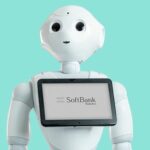Ohmygoodness, AI Humanoid Robotics??? What planet, century, or dimension are we in here? Sounds a wee bit terrifying on first blush. But read on and learn where this industry innovation is headed and who the major players within the sector are.
 You may be interested to learn that AI is actually nothing new and has been referenced for thousands of years. We’ve sourced several links for you to dig a bit deeper as you have time, and we think you will be surprised to learn that we’ve been talking about AI for a very long time.
You may be interested to learn that AI is actually nothing new and has been referenced for thousands of years. We’ve sourced several links for you to dig a bit deeper as you have time, and we think you will be surprised to learn that we’ve been talking about AI for a very long time.
The AI Industry’s Origin
The history of artificial intelligence (AI) actually began in antiquity, with myths, stories, and rumors of artificial beings endowed with intelligence or consciousness by master craftsmen5. The seeds of modern AI were planted by philosophers who attempted to describe the process of human thinking as the mechanical manipulation of symbols5. This work culminated in the invention of the programmable digital computer in the 1940s5.
The field of AI research was later founded at a workshop held on the campus of Dartmouth College, USA during the summer of 19565.
And as we know, AI has been present within the marketplace since then, though it recently exploded in visibility with the massive leap forward in Generative AI.
The AI Humanoid Robotics Industry
Let’s dig a bit deeper. The humanoid robotics market is on a trajectory of rapid growth. Projections indicate a rise in market cap from $1.6 billion in 2022 to a projected $214.4 billion by 20322. This growth is expected to be fueled by the increasing demand for humanoid robots in various sectors, including personal assistance, entertainment, education, and healthcare2.
The emergence of generative AI, which we will delve into in another “AI EDUCATION” post in the near future, also opens up new solutions for this sector1. Predictive AI analyzing robot performance data could potentially map out the future state of equipment and could also save manufacturers machine downtime costs1. However, the industry certainly faces challenges in software development, manufacturing, and creating a robust service infrastructure to support these advanced machines4. (Think how challenging it has been for the EV market to create a meaningful infrastructure, and you get the picture.)
 Those who have followed us over the years may remember that at our previous media firm -FintekNews– we frequently covered AI applications in fintech (as we continue to do with AI & Finance and Digital Wealth News), and one of our favorite subjects in the sector at that time was Softbank’s humanoid robot “Pepper”, perhaps the most famous AI humanoid robot of them all.
Those who have followed us over the years may remember that at our previous media firm -FintekNews– we frequently covered AI applications in fintech (as we continue to do with AI & Finance and Digital Wealth News), and one of our favorite subjects in the sector at that time was Softbank’s humanoid robot “Pepper”, perhaps the most famous AI humanoid robot of them all.
Softbank’s current website (as of 2/24) touts that Pepper is available for use in healthcare, senior living, hospitality, commercial cleaning(!), higher education, plus “workplace” and “multi-family”. Early on, Softbank was promoting its use as a greeter in bank branches to assist customers with banking questions before moving them over to live tellers (or perhaps replacing them), but the technology has clearly evolved since its launch to move into a myriad of other industries.
Below is a list of some of the other leading firms within the AI human robotics sector, including Softbank, of course.
Top 10 AI Humanoid Robotics Firms
- Sanctuary AI: Their humanoid robot, Phoenix, is the world’s first general-purpose robot powered by Sanctuary AI’s pioneering AI control system: Carbon9.
- SoftBank Robotics: They have created Pepper (see above), a semi-humanoid robot designed with the ability to read emotions9.
- Engineered Arts: They have developed Ameca, one of the world’s most advanced human-shaped robots9.
- UBTECH Robotics: They have designed Walker X, an agile, smart companion operating as an intelligent, bipedal humanoid robot9.
- Hanson Robotics: Known for launching popular signature robots such as Professor Einstein, Albert HUBO, and Sophia, the first robot ever to be granted citizenship10.
- Agility Robotics: They have developed Digit, a bipedal robot designed for autonomous delivery9.
- Boston Dynamics: They have created Atlas, a bipedal humanoid robot designed to undertake a variety of search and rescue tasks9.
- Toyota: Their T-HR3 is a third-generation humanoid robot designed to assist humans in various settings2.
- The University of Science and Technology of China: They have developed Jia Jia, a humanoid robot9.
- NASA and General Motors: They have jointly developed Robonaut 2, a humanoid robot9.
We hope you’ve enjoyed learning a bit more about AI Humanoid Robotics.
As we’ve said MANY times, don’t be afraid of AI. Embrace it, learn about it, and use it to your advantage!!
Written by DWN Team & CoPilot
REFERENCES:
1. Top 10: Humanoid Robots | AI Magazine
2. 12 top companies in the vanguard of the rise of humanoid robots
3. The Dawn Of Humanoid Robotics: A Glimpse Into The Future – Forbes
4. History of artificial intelligence – Wikipedia
5. Top 5 Robot Trends 2024 – International Federation of Robotics
6. Humanoid Robots: Shaping the Future of AI and Work
7. Top 22 Humanoid Robots in Use Right Now | Built In
8. A brief history of robotics and AI – Tech Advisor
9. History of robots – Wikipedia
10. Humanoid robotics—History, current state of the art, and challenges
11. 10 Humanoid Robotic Companies to Look Out For – Robotics 24/7
12. Top humanoid robots companies | VentureRadar
13. 31 AI Robotics Companies Driving Innovation | Built In
DWN Staff with CoPilot







